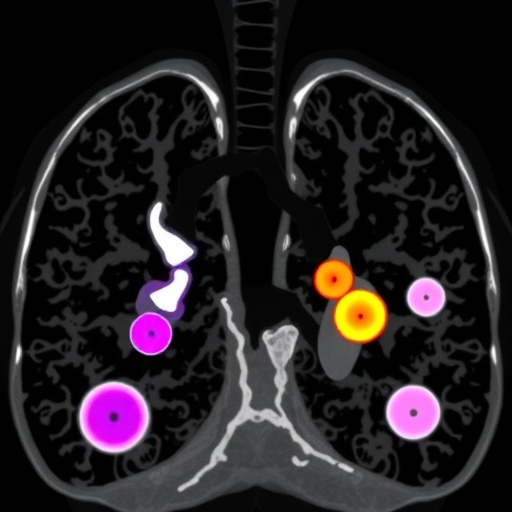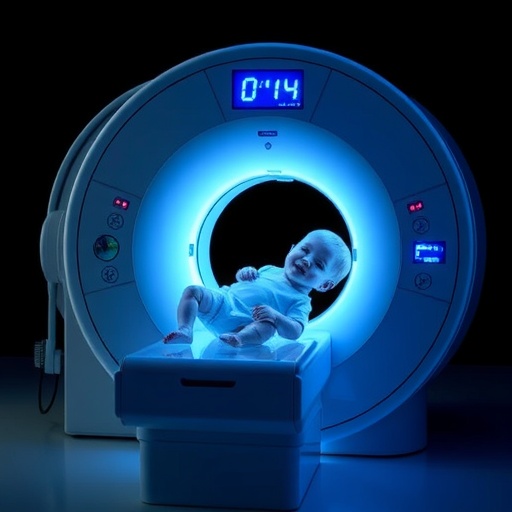
In the evolving landscape of lung cancer screening, the detailed assessment of pulmonary subsolid nodules (SSNs) has emerged as a critical component in early diagnosis and management. A recent observational study published in the Journal of Thoracic Disease sheds new light on how respiratory phases profoundly influence the quantitative measurements of SSNs obtained via low-dose computed tomography (LDCT). Given the intricacies of lung anatomy and physiology during breathing cycles, this research emphasizes the necessity of stable and consistent CT acquisition protocols, particularly highlighting the impact of lung inflation states on volumetric and dimensional CT parameters.
Pulmonary subsolid nodules, characterized by their ground-glass opacity and part-solid components, present unique challenges in imaging due to their subtle differences from solid nodules. Accurate measurement of these nodules can dictate clinical decisions, especially regarding growth assessment over time, which is vital for differentiating benign lesions from early malignancies. Traditionally, follow-ups rely heavily on changes in size and volume, under the assumption that CT acquisition conditions remain consistent across scans. However, the respiratory phase during image capture affects lung morphology and the relative position of nodules, potentially leading to variability in quantitative measurements.
The study retrospectively analyzed 255 pulmonary subsolid nodules from 230 individuals who underwent paired inspiratory and expiratory low-dose CT scans. By comparing the three-dimensional quantitative parameters — including lung volume, nodule diameter (both long and short axes), surface area, volume, and density — between inspiration and expiration phases, the researchers sought to quantify the extent and nature of measurement discrepancies attributable to respiratory variation. The analysis introduced a novel change ratio metric, representing the proportional difference of the parameter measured during expiration relative to inspiration, denoted as (E-I)/I.
.adsslot_c402IoLfWV{width:728px !important;height:90px !important;}
@media(max-width:1199px){ .adsslot_c402IoLfWV{width:468px !important;height:60px !important;}
}
@media(max-width:767px){ .adsslot_c402IoLfWV{width:320px !important;height:50px !important;}
}
ADVERTISEMENT
Results from this comprehensive evaluation indicated statistically significant differences in all measured parameters of SSNs between inspiratory and expiratory CT acquisitions. Notably, the volume of nodules exhibited the greatest variability, with an average change ratio exceeding 20%. This suggests that volumetric assessments are particularly susceptible to alterations induced by changes in lung inflation, resonating with the understanding that volume measurements inherently magnify dimensional variability due to their cubic relationship to linear dimensions.
Conversely, the long axis diameter of nodules demonstrated the smallest change ratio, approximately 7%, implying that linear measurements along the longest dimension are comparatively more stable across respiratory phases. This disparity in the susceptibility of various quantitative metrics to breathing-related changes presents important clinical implications — particularly that volumetric assessments might overestimate or underestimate nodule growth if the respiratory phase during serial imaging differs.
A further layer of complexity emerged when the influence of nodule density type was analyzed. Part-solid nodules (PSNs) and pure ground-glass nodules (pGGNs) exhibited significant differences in the change ratios of most quantitative parameters, indicating that the degree of solidity within a nodule may modulate its response to inspiration and expiration dynamics. This highlights the heterogeneity among SSNs and suggests that tailored interpretation of CT metrics could be warranted based on nodule composition.
Interestingly, nodule size — subdivided into groups ≤10 mm and >10 mm — did not significantly affect the variability in change ratios, indicating that respiratory phase-induced measurement discrepancies are relatively size-independent within the ranges studied. However, anatomical location within the lung did manifest as a differential factor; nodules in the lower lobes exhibited significantly greater change ratios in density than those in the upper lobes. This likely reflects the greater mechanical movement and volumetric change in the lower lung regions during respiratory cycles.
The researchers also stratified nodules into “changed” and “unchanged” groups based on established growth criteria during follow-up. Quantitative parameters from inspiratory CT scans and change ratios differed significantly between these groups, underscoring that respiratory phase not only affects absolute measurements but may influence clinical categorizations of nodule progression. This finding accentuates the risk of misinterpretation in longitudinal CT surveillance when respiratory phase control is lacking.
Multivariate logistic regression analysis distilled several independent predictors for whether SSNs exhibited change-related measurement variability with respiratory phase shifts. Lung density and multiple nodule characteristics measured during inspiratory CT — including long axis diameter, short axis diameter, surface area, and density — emerged as significant indicators. These parameters could potentially be integrated into predictive models to adjust for respiratory phase effects or to enhance the reliability of nodule assessment protocols.
From a practical standpoint, this study’s insights bear direct consequences for the workflow of lung cancer screening programs utilizing LDCT. Inconsistent control of patient breath-holding and variable respiratory phase during image acquisition may compromise the comparability of serial scans, leading to erroneous assumptions of nodule growth or stability. This is especially critical given that decisions regarding invasive interventions or continued surveillance hinge upon subtle changes detected over time.
Technological and procedural adaptations may be warranted to mitigate respiratory phase variability. Standardizing breath-hold instructions, implementing spirometry-controlled CT acquisition, or leveraging advanced image registration and correction algorithms could enhance the fidelity of longitudinal nodule assessment. Additionally, interpreting physicians should exercise caution when evaluating volumetric changes without accounting for potential respiratory phase discrepancies.
The study highlights the dichotomy between linear and volumetric assessments of SSNs, suggesting that reliance solely on volumetric data could introduce significant inaccuracies. Incorporating multiple quantitative metrics alongside clinical context and adhering to consistent imaging protocols can optimize diagnostic accuracy. Furthermore, distinction in behavior between PSNs and pGGNs calls for nuanced imaging interpretation tailored to nodule subtypes.
In conclusion, this investigation elucidates the crucial role of respiratory mechanics in shaping the quantitative parameters of pulmonary subsolid nodules during low-dose CT screening. Recognizing and controlling for respiratory phase effects is imperative to avoid misjudgement in nodule growth determination, thus refining lung cancer screening efficacy and patient management. As lung imaging technology advances, integrating physiological considerations into acquisition and analysis protocols will fortify the precision of pulmonary nodule evaluation.
Subject of Research: Human tissue samples
Article Title: Effect of respiratory phase on three-dimensional quantitative parameters of pulmonary subsolid nodules in low-dose computed tomography screening for lung cancer
News Publication Date: 27-Mar-2025
Web References: http://dx.doi.org/10.21037/jtd-24-1440
Keywords: Lung cancer, Radiology
Tags: challenges in imaging ground-glass opacitiesconsistency in CT acquisition protocolseffects of lung inflation on CT parametersimplications for early lung cancer diagnosisimportance of imaging stability in lung cancer screeninglow-dose CT lung cancer screeningpulmonary subsolid nodules analysisquantitative assessment of lung nodulesrespiratory phase influence on CT imagingretrospective study of lung nodulesvariability in nodule size measurementsvolumetric measurements in lung cancer





